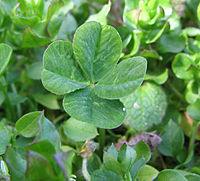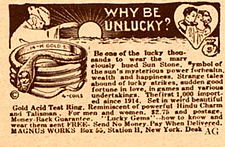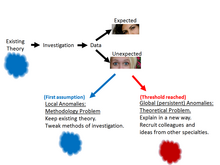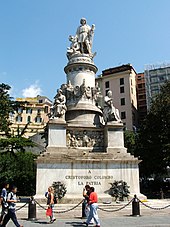In Western culture, a four-leaf clover is often considered to bestow good luck.
Luck is the phenomenon and belief that defines the experience of notably positive, negative, or improbable events. The naturalistic
interpretation is that positive and negative events may happen all the
time, both due to random and non-random natural and artificial
processes, and that even improbable events can happen by random chance. In this view, the epithet "lucky" or "unlucky" is a descriptive label that refers to an event's positivity, negativity, or improbability.
Supernatural
interpretations of luck consider it to be an attribute of a person or
object, or the result of a favorable or unfavorable view of a deity upon a person. These interpretations often prescribe
how luckiness or unluckiness can be obtained, such as by carrying a
lucky charm or offering sacrifices or prayers to a deity. Saying
someone is "born lucky" then might mean, depending on the
interpretation, anything from that they have been born into a good
family or circumstance, or that they habitually experience improbably
positive events due to some inherent property or the lifelong favor of a
god or goddess in a monotheistic or polytheistic religion.
Many superstitions are related to luck, though these are often specific to a given culture or set of related cultures, and sometimes contradictory. For example, lucky symbols include the number 7 in Christian-influenced cultures, but the number 8 in Chinese-influenced cultures. Unlucky symbols
and events include entering and leaving a house by different doors in
Greek culture, throwing rocks into the wind in Navajo culture, and ravens
in Western culture. Some of these associations may derive from related
facts or desires. For example, in Western culture opening an umbrella
indoors might be considered unlucky partly because it could poke someone
in the eye, whereas shaking hands with a chimney sweep
might be considered lucky partly because it is a kind but unpleasant
thing to do given the dirty nature of their work. In Chinese culture,
the association of the number 4 as a homophone
with the word for death may explain why it is considered unlucky.
Extremely complicated and sometimes contradictory systems for
prescribing auspicious and inauspicious times and arrangements of things
have been devised, for example feng shui in Chinese culture and systems of astrology in various cultures around the world.
Many polytheistic religions have specific gods or goddesses that are associated with luck, both good and bad, including Fortuna and Felicitas in the Ancient Roman religion (the former related to the words "fortunate" and "unfortunate" in English), Dedun in Nubian religion, the Seven Lucky Gods in Japanese mythology, mythical American serviceman John Frum in Polynesian cargo cults, and the inauspicious Alakshmi in Hinduism.
Etymology and definition
1927 advertisement for lucky jewellery. "Why Be Unlucky?".
The English noun luck appears comparatively late, during the 1480s, as a loan from Low German, Dutch or Frisian luk, a short form of gelucke (Middle High German gelücke). Compare to old Slavic word lukyj (лукый) - appointed by destiny and old Russian luchaj (лучаи) - destiny, fortune. It likely entered English as a gambling
term, and the context of gambling remains detectable in the word's
connotations; luck is a way of understanding a personal chance event.
Luck has three aspects:
- Luck is good or bad.
- Luck is the result of chance.
- Luck applies to a sentient being.
Before the adoption of luck at the end of the Middle Ages, Old English and Middle English expressed the notion of "good fortune" with the word speed (Middle English spede, Old English spēd); speed besides "good fortune" had the wider meaning of "prosperity, profit, abundance"; it is not associated with the notion of probability or chance but rather with that of fate or divine help; a bestower of success can also be called speed, as in "Christ be our speed" (William Robertson, Phraseologia generalis, 1693).
The notion of probability was expressed by the Latin loanword chance, adopted in Middle English from the late 13th century, literally describing an outcome as a "falling" (as it were of dice), via Old French cheance from Late Latin cadentia "falling". Fortuna,
the Roman goddess of fate or luck, was popular an allegory in medieval
times, and even though it was not strictly reconcilable with Christian
theology, it became popular in learned circles of the High Middle Ages
to portray her as a servant of God in distributing success or failure in
a characteristically "fickle" or unpredictable way, thus introducing
the notion of chance.
Interpretations
Luck is interpreted and understood in many different ways.
As lack of control
Luck refers to that which happens to a person beyond that person's control. This view incorporates phenomena
that are chance happenings, a person's place of birth for example, but
where there is no uncertainty involved, or where the uncertainty is
irrelevant. Within this framework, one can differentiate between three
different types of luck:
- Constitutional luck, that is, luck with factors that cannot be changed. Place of birth and genetic constitution are typical examples.
- Circumstantial luck—with factors that are haphazardly brought on. Accidents and epidemics are typical examples.
- Ignorance luck, that is, luck with factors one does not know about. Examples can be identified only in hindsight.
Circumstantial luck with accidental happenstance of favorable discoveries and/or inventions is serendipity.
As a fallacy
Another view holds that "luck is probability taken personally." A rationalist approach to luck includes the application of the rules of probability and an avoidance of unscientific beliefs. The rationalist thinks that the belief in luck is a result of poor reasoning or wishful thinking. To a rationalist, a believer in luck who asserts that something has influenced his or her luck commits the "post hoc ergo propter hoc" logical fallacy: that because two events are connected sequentially, they are connected causally as well. In general:
A happens (luck-attracting event or action) and then B happens;
Therefore, A influenced B.
More contemporary authors writing on the subject believe that the
definition of good destiny is: One who enjoys good health; has the
physical and mental capabilities of achieving his goals in life; has
good appearance, and; has happiness in mind and is not prone to
accidents.
In the rationalist perspective, probability is only affected by confirmed causal connections.
The gambler's fallacy and inverse gambler's fallacy both explain some reasoning problems in common beliefs in luck. They involve denying the unpredictability of random events: "I haven't rolled a seven all week, so I'll definitely roll one tonight".
Philosopher Daniel Dennett wrote that "luck is mere luck" rather than a property of a person or thing.
As an essence
Maneki-neko with Seven Lucky gods.
There is also a series of spiritual, or supernatural
beliefs regarding fortune. These beliefs vary widely from one to
another, but most agree that luck can be influenced through spiritual
means by performing certain rituals or by avoiding certain circumstances.
Luck can also be a belief in an organization of fortunate and unfortunate events. Luck is a form of superstition which is interpreted differently by different individuals. Carl Jung coined the term synchronicity, which he described as "a meaningful coincidence".
Abrahamic religions believe God controls future events; belief in luck or fate is criticised in Book of Isaiah chapter 65, verses 11-12:
- What will happen to you for offering food and wine to the gods you call good luck and fate? Your luck will end.
Belief in the extent of Divine Providence varies; most acknowledge providence as at least a partial, if not complete influence on luck. Christianity, in its early development, accommodated many traditional practices which at different times, accepted omens and practiced forms of ritual sacrifice in order to divine the will of their supreme being or to influence divine favoritism. The concepts of "Divine Grace" or "Blessing" as they are described by believers closely resemble what is referred to as "luck" by others.
Mesoamerican religions, such as the Aztecs, Mayans and Incas,
had particularly strong beliefs regarding the relationship between
rituals and the gods, which could in a similar sense to Abrahamic
religions be called luck or providence. In these cultures, human
sacrifice (both of willing volunteers and captured enemies), as well as
self-sacrifice by means of bloodletting,
could possibly be seen as a way to propitiate the gods and earn favor
for the city offering the sacrifice. An alternative interpretation
would be that the sacrificial blood was considered as a necessary
element for the gods to maintain the proper working order of the
universe, in the same way that oil would be applied to an automobile to
keep it working as designed.
Many traditional African practices, such as voodoo and hoodoo,
have a strong belief in superstition. Some of these religions include a
belief that third parties can influence an individual's luck. Shamans and witches are both respected and feared, based on their ability to cause good or bad fortune for those in villages near them.
As a self-fulfilling prophecy
Some evidence supports the idea that belief in luck acts like a placebo, producing positive thinking and improving people's responses to events.
In personality psychology, people reliably differ from each other
depending on four key aspects: beliefs in luck, rejection of luck,
being lucky, and being unlucky. People who believe in good luck are more optimistic, more satisfied with their lives, and have better moods.
People who believe they are personally unlucky experience more
anxiety, and less likely to take advantage of unexpected opportunities. One 2010 study found that golfers who were told they were using a "lucky ball" performed better than those who were not.
Some people intentionally put themselves in situations that increase the chances of a serendipitous encounter, such as socializing with people who work in different fields.
Social aspects
Wheel of fortune as depicted in Sebastian Brant's book, author Albrecht Dürer
Luck is an important factor in many aspects of society.
Games
The
philosopher Nicholas Rescher has proposed that the luck of someone's
result in a situation of uncertainty is measured by the difference
between this party's yield and expectation: λ = Y - E. Thus skill
enhances expectation and reduces luck. The extent to which different games will depend on luck, rather than skill or effort, varies considerably. For example, chess does not involve any random factors (beyond the determination of which player moves first), while the outcome of Snakes and Ladders is entirely based on random dice rolls. In poker,
especially games with a communal board, pure luck may decide a winning
hand. Luck in games involving chance is defined as the change in a
player's equity after a random event such as a die roll or card draw.
Luck is positive (good luck) if the player's position is improved and
negative (bad luck) if it is worsened. A poker player who is doing well
(playing successfully, winning) is said to be "running good".
Almost all sports contain elements of luck. A statistical analysis in the book The Success Equation attempted to elucidate the differing balance between skill and luck with respect to how teams finished in the major North American sports leagues. This analysis concluded that, on a luck-skill continuum, the NBA had the most skill-dependant result while that of the NHL was most luck-dependant.
Lotteries
A defining feature of a lottery is that winners are selected purely
by chance. Marketing and other discussions regarding lotteries often
mention luck.
Means of resolving issues
"Leaving it to chance" is a way of resolving issues. For example, flipping a coin at the start of a sporting event may determine who goes first.
Numerology
Most cultures consider some numbers to be lucky or unlucky. This is found to be particularly strong in Asian cultures, where the obtaining of "lucky" telephone numbers, automobile license plate numbers, and household addresses are actively sought, sometimes at great monetary expense. Numerology,
as it relates to luck, is closer to an art than to a science, yet
numerologists, astrologists or psychics may disagree. It is interrelated
to astrology, and to some degree to parapsychology and spirituality and is based on converting virtually anything material into a pure number,
using that number in an attempt to detect something meaningful about
reality, and trying to predict or calculate the future based on lucky
numbers. Numerology is folkloric
by nature and started when humans first learned to count. Through human
history it was, and still is, practiced by many cultures of the world
from traditional fortune-telling to on-line psychic reading.
Science
Different thinkers like Thomas Kuhn have discussed the role of chance in scientific discoveries.
Richard Wiseman
did a ten-year scientific study into the nature of luck that has
revealed that, to a large extent, people make their own good and bad
fortune. His research revealed that "Lucky people generate their own
good fortune via four basic principles. They are skilled at creating and
noticing chance opportunities, making lucky decisions by listening to
their intuition, creating self-fulfilling prophecies via positive
expectations, and adopting a resilient attitude that transforms bad luck
into good." Researchers have suggested that good luck and good mood often co-occur (Duong & Ohtsuka, 2000)
and that lucky people are happy and optimistic whereas unlucky people
feel anxious and depressed (Day & Maltby, 2003; Wiseman, 2003).
Although previous studies have explored the antecedents and consequences of luck using attribution theory (e. g., Fischoff,
1976; Weiner et al., 1987), personality variables (Darke & Freedman, 1997a;b),
and more recently a cognitive priming approach (DeMarree et al., 2005;
Kramer & Block, 2008) research on the underlying mechanism of how
luck influences consumer judgment and behavior has been noticeably
absent in the extant literature. Moreover, in much of this previous
work, luck is manipulated in a way that is very likely to elicit
positive affect as well. Thus, it is difficult to articulate whether the
observed effects of luck are due to chronic beliefs about luck,
temporary changes in how lucky people feel, or because of changes caused
by the positive affect that is experienced. Their research showed that
priming participants subliminally with luck-related stimuli made them
feel luckier and happier. It was also found that the effects of priming
luck using subliminal messages
increased participants' estimates of the likelihood of favorable
events, their participation in lotteries, the amount of money they
invested in relatively risky financial options and these effects
appeared to be mediated by temporary changes in perceptions of luck
rather than by affect).
In religion and mythology
Buddhism
Gautama Buddha, the founder of Buddhism,
taught his followers not to believe in luck. He taught that all things
which happen must have a cause, either material or spiritual, and do not
occur due to luck, chance or fate. The idea of moral causality, karma (Pali: kamma), is central in Buddhism. In the Sutta Nipata, the Buddha is recorded as having said the following about selling luck:
Whereas some religious men, while living of food provided by the faithful make their living by such low arts, such wrong means of livelihood as palmistry, divining by signs, interpreting dreams ... bringing good or bad luck ... invoking the goodness of luck ... picking the lucky site for a building, the monk Gautama refrains from such low arts, such wrong means of livelihood. D.I, 9–12
However, belief in luck is prevalent in many predominantly Buddhist countries. In Thailand, Buddhists may wear verses (takrut) or lucky amulets which have been blessed by monks for protection against harm.
Christianity and Judaism
Proverbs 16:33 states "the lot is cast into the lap, but the whole disposing thereof is of the Lord". Ecclesiastes
9:11 states: "chance happeneth to them all". Proverbs 16:33 would
indicate that something as random as the rolling of dice or the tossing
of a coin is not outside of God's sovereign control. And, therefore, its
results are not merely of chance.
God's sovereignty involves two aspects. God's active will or
sovereignty would involve something he causes to happen such as the
leading of wicked King Ahab into battle (2 Chronicles 18:18-19). Ahab's
death was not merely the result of a randomly shot arrow, but as 2
Chronicles 18 reveals, God actively directed the events that led Ahab
into battle and used that randomly shot arrow to accomplish his intended
will for Ahab that day.
God's passive will involves him allowing, rather than causing,
something to happen. Chapter 1 of the book of Job illustrates this in
what God allowed Satan to do in the life of Job. It is also involved in
the evil that God allowed Joseph's brothers to do to Joseph in order to
accomplish a greater good, a good not apparent to Joseph until years
later (Genesis 50:20).
Hinduism
The Gita says; “ Set thy heart upon selfless performance of thy
natural duty (Svakarma, Svadharma ) , but never on its reward . Work not
for a reward ; but never cease to do thy work “ . ( Gita , 2 . 47 ) .
There are five causes of all actions as given in the Samkhya wisdom ; says Gita—
“The physical body ( adhisthana ) , the lower’I am’ ( karta ) ,
the means of perception (karanam), the varied multiple efforts
(vividhasch pruthak cheshta ) and the Cosmic Wheel of Action ( daivam ),
these five sources together are responsible for success or failure of
any action “ . ( Gita, 18 . 14–15 ) .
Here the word ‘daivam’ does not mean luck, fate. fortune ,
providence or destiny. None of these English words are the exact synonym
for the Sanskrit word ‘Daivam’ here . ‘ Daivam ‘ is the Cosmic Whee of
Action ( Kshara-gati, Apara-Prakriti, Maya ) that keeps the perfect
account of our past and present actions.
A man who says ; “ Nothing is impossible for me; I am the only
hero of all these achievements ; who else is there like me ? “, he is a
man of clouded vision and he does not see the Truth
Islam
The
definition which is much closer to the concept of luck in Islam is "a
force that brings good fortune or adversity" Quran 17-13 (Isra): "And
(for) every man We have fastened to him his fate(fortune) in his neck,
and We will bring forth for him (on the) Day (of) the Resurrection a
record which he will find wide open". However, there is a very long
discussion on how this prefixed destiny, fortune or luck defines
attitudes and living behavior and so as to how much amends one can make
in this predetermined fate by one's own contribution through positive
actions in accordance with the teachings of Islam.
There is no concept of luck in Islam other than actions determined by Allah based on the merit of the choice made by human beings. It is stated in the Qur'an (Sura: Adh-Dhariyat
(The Winds that Scatter) verse:22) that one's sustenance is
pre-determined in heaven when the Lord says: "And in the heaven is your
provision and that which ye are promised." However, one should
supplicate towards Allah to better one's life rather than hold faith in
un-Islamic acts such as using "lucky charms". However, in the Arabic language there is a word which directly means "luck", which is حظ ḥaẓẓ, and a related word for "lucky", محظوظ maḥẓūẓ. It is also forbidden to believe in luck or anything else related to luck, as it is classified as shirk (associating partners to Allah or giving any share of any attribution which belongs to Allah and Allah alone).
The Tunisians retain some native beliefs of Berber origin such as the evil eye. A number of practices, such as shutters painted blue are also used to repel evil spirits.
Measuring belief in luck
A horseshoe on a door is regarded a protective talisman in some cultures
Belief in good luck
Darke and Freedman (1997) were the first researchers systematically to address directly both the concept and the measurement of belief in luck as a deterministic
and personal attribute. They define luck belief as the perception that
good luck is "a somewhat stable characteristic that consistently favors
some people but not others".
They define disbelief in luck as "a tendency to agree with the rational
view of luck as random and unreliable" (p. 490). To capture their
unidimensional definition of irrational luck belief, Darke and Freedman
developed a 12-item measure.
Unfortunately, they found their measure "does not seem particularly
good at distinguishing between people who [say] they [are] typically
lucky from those who [say] they [are] typically unlucky". They also found factor analyses of their measure produced a multi-component solution, as did Prendergast and Thompson (2008).
Multidimensional beliefs about luck
André (2006)
proposed a model of luck-related perceptions that includes separate
positive and negative beliefs. However, she found the positive and
negative components of personal luck beliefs correlate highly,
suggesting they are conceptually very close or in fact the same. Maltby
et al. (2008)
proposed a 6-dimensional model of beliefs around luck, but empirical
analyses supported only a 4-dimensional model: belief in being
personally lucky; belief in being personally unlucky; general belief in
luck; and rejection of belief in luck.
Belief in luck and luckiness
A barnstar, mounted on a wall, is seen as a lucky symbol in some parts of North America
Thompson and Prendergast (2013)
clarified the concepts of belief in luck and belief in personal
luckiness. They addressed the logical problem that nobody who
disbelieves in luck could consider themselves lucky by differentiating
between belief in luck as a deterministic phenomenon that affects the
future, on one hand, and on the other, belief in personal luckiness as
an appraisal of how fortunately or otherwise chance events in the past
might have turned out. They developed and validated an internationally
applicable scale to measure, respectively, belief in luck and personal
luckiness constructs. They found no correlation between the constructs
and no evidence of a distinction between positive and negative aspects
of each, suggesting they represent two discrete and unidimensional
constructs. Belief in luck and personal luckiness were also found to
correlate differently with personality and psychological variables, such
as the Big Five and affect.
















